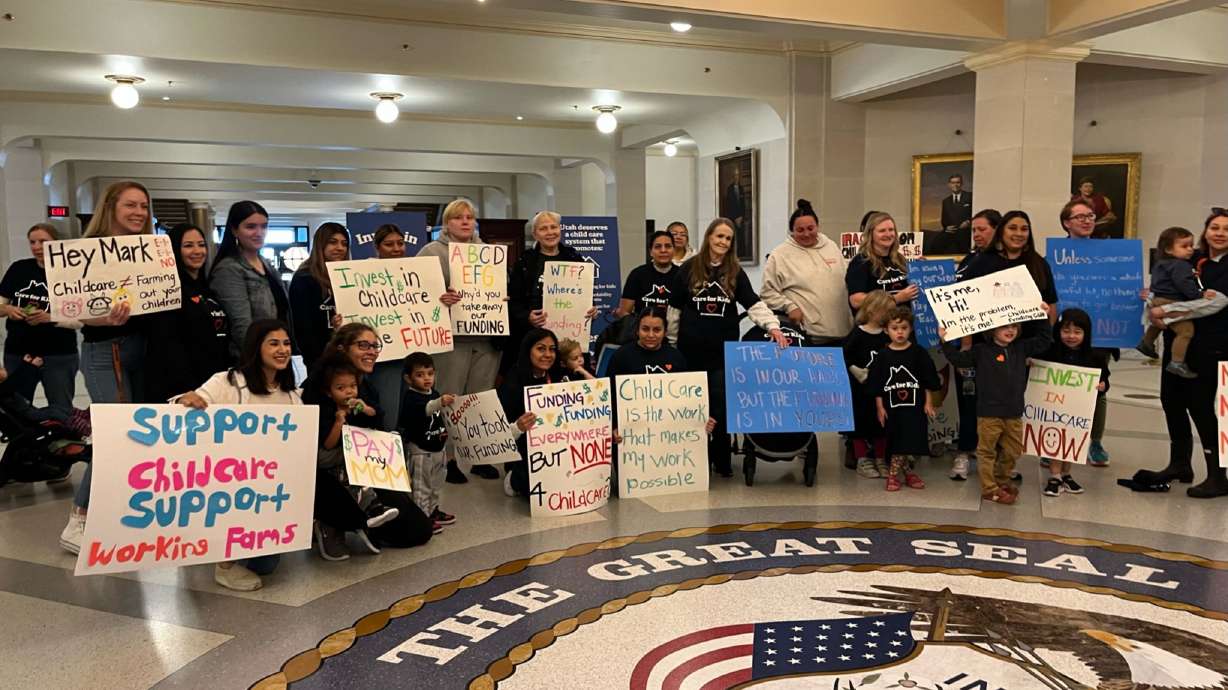Estimated read time: 4-5 minutes
This archived news story is available only for your personal, non-commercial use. Information in the story may be outdated or superseded by additional information. Reading or replaying the story in its archived form does not constitute a republication of the story.
SALT LAKE CITY —Utah parents and child care providers gathered at the Utah State Capitol Wednesday to call on lawmakers to prevent the system from falling into crisis as it edges closer to what they described as a child care "cliff."
"This crisis weighs on families regardless of income, location and party lines. This isn't a Salt Lake concern, this isn't a Wasatch Front concern, this isn't a rural-urban or suburban concern; this is a Utah concern, and it should be a legislative concern," said Brigette Weier, organizer for Care for Kids Network.
The call for intervention comes after federal child care stabilization grants ended on Sept. 30. Since the start of the pandemic, Utah has received nearly $600 million in emergency federal funding to ensure that the child care sector could continue to serve families amid COVID-era challenges, according to Voices for Utah Children.
The nonprofit predicts that by June 2024, nearly all of the COVID-era support for the state's child care system will be spent. Without federal or state intervention, that funding cliff could lead to the closure of child care facilities, increased expenses for families and more dramatic turnover in the workforce due to lowered wages.
"No matter where that education happens — whether it's in the home with a family, in a phone case or facility-based program, or half day — it doesn't matter; not funding care for kids is detrimental to the stability of our families, communities and state not just today, but for generations to come," said Weier.
The child care crisis existed long before the COVID-19 pandemic, with the state only having enough licensed child care to meet about 35% of its child care needs. With the help of federal funding and state funding from the Office of Child Care, licensed child care capacity in Utah has grown by 31% since March 2020. The child stabilization grants offered by the Office of Child Care helped providers cover unexpected costs associated with the pandemic, stabilize their businesses and pay their staff members $15 an hour or more.
"With the growing crisis, I've often wondered what would happen if child care centers closed. What would happen if child care providers did not show up? We witnessed this with the COVID-19 pandemic when centers had to close their doors due to quarantine or due to lack of a workforce," said Katie Martinez, director of Kids First Child Care. "Early childhood workers were now recognized as essentials for the workforce, yet we still remain in crisis today."
Martinez pointed to the difficulty of staying open, paying livable wages to staff and keeping tuition costs low for families. The end of federal funds could also mean wage losses for early child care educators who made approximately $10.47 per hour in Utah prior to the pandemic, on average less than a dog walker.
"The cost of child care is much more than a mortgage or rent payment; this is wrong. We are child care providers or early childhood educators who are in the business of supporting and caring for children — we cannot just walk away; we care too much," Martinez added.
The high cost of child care makes it less accessible to low- and middle-income families, with rural families struggling most. The average annual cost of care for two children under the age of 6 for a Utah family is about 17% of a four-person family's income. In Grand County, with the state's lowest median annual income at $42,654, the cost of care for a family of four would comprise about 41% of a family's income, according to Voices for Utah Children.
"After the birth of my children, I was faced with tough decisions due to limited options and support here in Utah. No. 1 was the affordability factor, No. 2 was the waitlists, and No. 3 was the inflexible workplaces that are not child- and family-friendly. We must ask ourselves: What choices are we providing to Utah's women, parents and caregivers?" said Melanie Call, a parent in Wednesday's rally. "Because I can tell you this: Being viewed differently the moment you become a parent, or being forced out of the workforce when you become a mother is not freedom of choice."
The cost of child care has forced some families to opt for a parent to stay home with the child or children. The impact of the child care system results in an economic loss for Utah parents at $101 million in earnings — as a result of being forced to cut work hours or leave the workforce — and $5.8 less in state income tax, according to Century Foundation. The foundation also estimates that without intervention, 35,614 children in Utah are expected to lose their child care as a result of the stabilization cliff. An additional 1,304 child care jobs are expected to be lost in Utah, at a minimum.
"State leaders can and need to find ways to continue these business-saving policies. With Utah lawmakers talking about overflowing state coffers and potential tax cuts, we know the money exists. These dollars can be redirected to make a real investment in the child care sector. Even small efforts like covering the costs associated with licensing or removing the bureaucratic burdens of city parking requirements can make an impact," wrote Voices for Utah Children.









